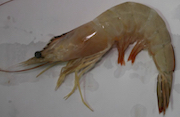Global shrimp trades
Shrimp are amongst the most internationally traded commodities, with a global traded amount of almost 17 billion US$ and a production of almost 7 million tons of shrimps including fishery and aquaculture (data in 2014 from FAO). More than 80% of the total production of shrimps (caught or farmed) is traded on the global market. Shrimps are considered a luxury product, which implies a high flexibility of the demand: a change in prices provokes a change in the demand (Lem 2006). Despite annual variations, the global shrimp market is growing (+ 75% over the last 15 years), and the prices are consistently falling as new actors are entering. The main shrimp consumers are developed countries, such as the US (568 000 tons for a value of 6.7 billion US$), Japan (223 000 tons in 2014, a 100 000 tons decline over the last decade), the EU (800 000 tons in 2014), and since recently, China and other growing countries. Traded shrimps are usually divided in three categories: frozen, not frozen and prepared or preserved. The profitability of producing shrimps is usually quite low (almost null), and an important fact is that fishermen and farmers are price-takers: the shrimp prices are dictated by the global market and not by the producers (Adams et al 2005).
Cold-water and tropical species
The 300 shrimp species of commercial interest can be roughly divided into two main categories: The fresh-water and the cold-water species. The cold-water species, whose main representative is the pink shrimp Pandalus borealis are only wild-caught. The main countries fishing for cold-water shrimps are Greenland, Canada, Iceland, Norway and the USA. Compared to tropical shrimps, the landings of cold-water shrimps are quite low: almost 300 000 tons in 2015.
The two main kinds of hot-water shrimps are white shrimps and tiger prawns. Hot-water shrimps can be either fished or farmed. The main producers of these commodities are Asian and South-American countries (white shrimps: China, Thailand, Brazil, Ecuador, Mexico, Vietnam; tiger prawns: Thailand, Vietnam, Indonesia and India). In 2014, the farmed shrimp production was of 3.6 million tons. Asia produced the bulk of it (3 million tons), whereas the rest (i.e. 671 000 tons) was produced in the Americas. Wild caught tropical shrimps accounted for more than 2.5 million tons. An important fact of the shrimp industry is that it is quite sensitive to environmental factors and confronted to new challenges (sustainability, decrease of prices, anti-dumping policies from importer countries …). For example, disease outbreaks (white stain, EMS) can severely decrease a production, such as in Ecuador in 2000 when a white stain outbreak occurred. Shrimp who represented up to 20% of the total exports of Ecuador dropped to only 5% (Marriott García 2003).

